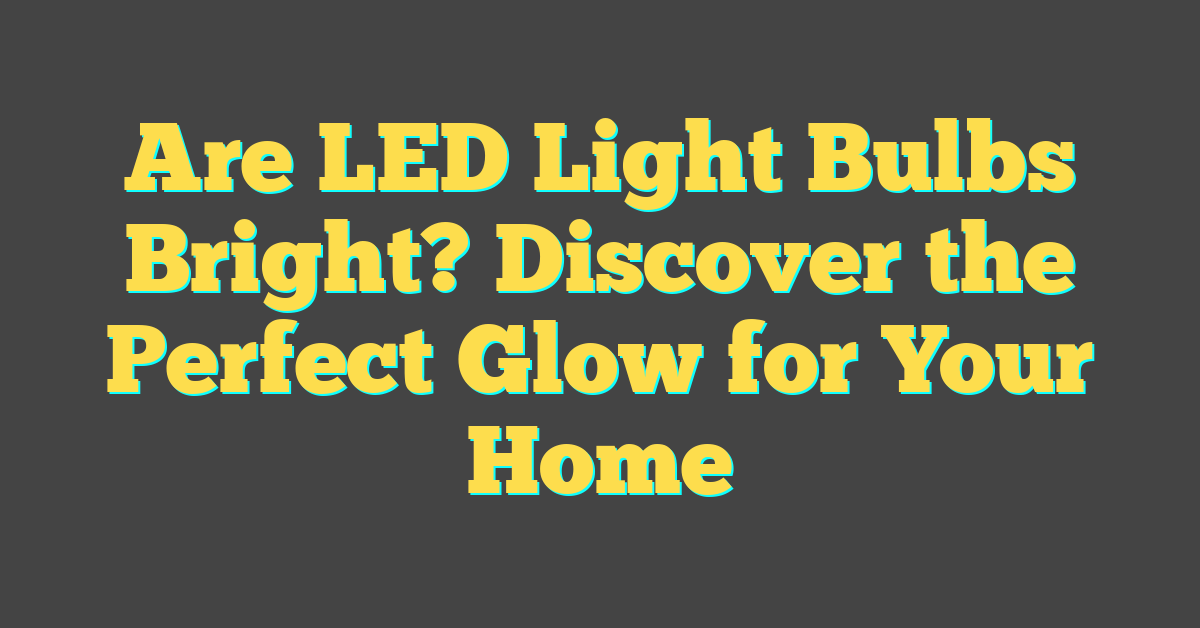Ever wondered if LED light bulbs can really brighten up your space like the old incandescent ones? You’re not alone. With the shift towards energy efficiency, it’s natural to question if these modern bulbs pack the same luminous punch.

The good news is, LED bulbs have come a long way. Not only do they offer comparable brightness, but they also bring a host of benefits that traditional bulbs can’t touch. Let’s shed some light on the subject and find out just how bright LED bulbs can be.
As you consider making the switch, you’re probably looking for that sweet spot between brightness and efficiency. Stick around, and you’ll discover exactly what LED light bulbs have to offer.
How Bright are LED Light Bulbs?
When you’re knee-deep in a DIY home project, knowing the luminosity of your lighting can make all the difference in your workspace. LED light bulbs have carved out a reputation for their remarkable brightness. Unlike their incandescent predecessors, LEDs don’t waste energy on heat, meaning nearly all their power is dedicated to producing light.
Lumens, not watts, are the real indicator of brightness. An incandescent bulb uses far more watts to produce the same number of lumens as an LED. For example, a standard 60-watt incandescent bulb puts out about 800 lumens of light. In contrast, an LED bulb requires only about 8 to 12 watts to yield the same brightness. Here’s a quick comparison:
| Bulb Type | Watts Used | Lumens Produced |
|---|---|---|
| Incandescent | 60 | 800 |
| LED | 10 | 800 |
The LED’s efficiency is clear—it provides the same light intensity using significantly less energy.
But what about the quality of light? LED bulbs have advanced to where they emit a wide spectrum of light color temperatures. Whether you love a warm, cozy glow for your living area or a bright, white light for your kitchen and workspaces, there’s an LED solution for you.
As you browse the shelves or online stores for LEDs, you’ll notice labels with ‘equivalent wattage’—a handy guide to help you find an LED with the brightness you’re used to from incandescent bulbs. Manufacturers typically list the incandescent equivalent on LED packaging, making your transition to LED lighting smoother.
Remember, your lighting choices can dramatically influence the ambiance and functionality of your space. LEDs have the versatility and intensity to accommodate both your aesthetic and practical needs, all while keeping energy consumption on the low. Keep this in mind as you plan your lighting scheme—whether it’s for your latest home improvement endeavor or simply replacing a burnt-out bulb in your reading lamp.
Comparing LED Bulbs to Incandescent Bulbs

When you walk down the lighting aisle, you might find yourself nostalgic for the good old days, looking at the familiar shape of incandescent bulbs. But as your eyes drift to the LED section, it’s clear that the landscape of home lighting has shifted significantly. Trust me, once you get to know LEDs, you’ll see why they’re the new favorites for both brightness and efficiency.
LED bulbs have a reputation for longevity. I’m talking about a lifespan that outshines their incandescent cousins by years. Imagine changing your lights less often while slashing your electricity bills; that’s the beauty of LEDs. They last an average of 25,000 hours compared to the meager 1,000 hours of an incandescent.
Here’s a breakdown of average lifespans and efficiencies:
| Type | Average Lifespan (hours) | Energy Efficiency |
|---|---|---|
| LED | 25,000 | Very High |
| Incandescent | 1,000 | Low |
Brightness is another area where LEDs excel. It’s all about the lumens. While a 60-watt incandescent bulb gives off about 800 lumens, an LED needs only about 8 to 12 watts to provide the same level of brightness. And let’s not forget, with LEDs, you get to decide the color temperature of your light – something that wasn’t an option with the warm glow of incandescents.
- Less Watts, More Lumens
- Customizable Color Temperatures
As an enthusiast constantly hunting for the perfect light to set the mood or highlight my latest DIY project, LED bulbs offer a level of control that incandestents simply can’t match. You gain not just a well-lit space but also the capacity to tailor your environment’s ambiance to your exact liking.
« What Happens When Light Bulb Burns Out: Secrets Unveiled & Lifespan Tips
Is Light Bulb Important? Discover How Your Lighting Choices Impact Health »
LEDs also tend to distribute light more efficiently, often providing a more uniform light spread, which is crucial for both task lighting and creating a warm atmosphere. And let’s not overlook the compatibility of LEDs with dimming systems, which allows for even greater ambiance control without compromising on brightness when you need it.
The Benefits of LED Light Bulbs

You’ve probably heard rave reviews about LED light bulbs, but what really sets them apart from their incandescent ancestors? Well, let’s shed some light on the benefits that make LEDs not just a choice, but a brilliant upgrade for your lighting needs.
LED bulbs shine bright without guzzling electricity, which is a win-win for both your utility bills and the environment. Unlike incandescent bulbs, which waste a lot of energy as heat, LEDs are the efficiency champions of the lighting world. They require far fewer watts to give off the same, or often even better, level of brightness. Imagine lighting up your room with just a fraction of the power previously used – that’s the LED advantage.
- Incandescent bulbs: 60 watts for a standard bulb
- LED bulbs: As low as 10 watts for the same brightness
| Bulb Type | Wattage Required for Equivalent Brightness |
|---|---|
| Incandescent | 60 watts |
| LED | ~10 watts |
Furthermore, LEDs aren’t one-trick ponies; they offer customizable color temperatures ranging from warm yellows to cool whites. This means you have the power to set the perfect mood for any room, be it a cozy bedroom ambiance or a focused home office vibe. It’s this kind of flexibility that makes LEDs incredibly popular in homes and workspaces alike.
Then there’s the longevity factor. With LEDs, you’re not just updating the look and efficiency of your home – you’re making an investment. These bulbs are designed to last, which means fewer trips to the store and more time enjoying uninterrupted, quality light. Your DIY projects can continue long into the night with the reliable glow of an LED bulb illuminating your workspace.
Remember those dimming systems you’ve always loved? LED bulbs are fully compatible with these, providing the control necessary for a truly tailored lighting experience. Whether you’re hosting a movie night and need a theater ambiance or you’re setting up for a romantic dinner, the right LED can dial in the perfect brightness without a flicker.
By embracing LED technology, you’re not just choosing a bulb; you’re embracing a brighter, more efficient, and customizable lighting solution that compliments both your aesthetic and practical needs. So next time you reach for the light switch, you’ll know you’ve made a choice that shines above the rest.
Factors that Affect LED Bulb Brightness

When you’re on the hunt for that perfect LED bulb, you might think it’s all about wattage. Not so fast! There’s much more to the story. Brightness in LED bulbs is influenced by several key factors, and understanding these will help you make an informed decision for that next DIY lighting project.
Lumens measure the actual brightness, as opposed to watts, which indicate energy usage. More lumens mean a brighter light; fewer lumens mean a softer light. It’s that simple. But don’t overlook color temperature. Measured in Kelvins (K), color temperature dramatically shifts the feel of the light. A lower Kelvin rating implies a warmer, yellowish glow, while a higher rating gives off a crisp, bluer light. The table below provides a quick reference:
| Lumens | Brightness Level |
|---|---|
| 450 – 800 | Soft to Moderate |
| 1100 – 1600 | Bright |
| 1600+ | Very Bright |
Got the lumens sorted? Excellent. Now, the direction of light is crucial too. A bulb with a focused beam angle channels light to a specific area, making it seem more intense. A widespread angle diffuses the light, leading to a gentler illumination great for ambiance.
Lastly, the bulb’s design plays its part. Heat sink efficiency and driver quality can affect light output and longevity. Some bulbs even boast innovative designs that enhance brightness while extending the bulb’s life.
When it comes down to it, finding the right LED bulb for your space isn’t just about hitting the bright spot. Take in all the factors—lumens, color temperature, beam angle, and build quality. Arm yourself with knowledge, my friend, because with LEDs, the power (and dare I say, the perfect lighting) is truly in your hands. Keep exploring, tweaking, and enjoying the journey to the illumination that fits your space like a glove.
Choosing the Right LED Bulb for Your Needs

When you’re revamping your home’s lighting or just replacing a flickered-out friend, picking the right LED bulb is crucial. Imagine walking into a room bathed in the perfect glow—that’s what choosing well can do. Your space, your mood, and even your energy bill will thank you! Let’s dive into what you need to keep in mind.
Lumens are your go-to for brightness. It’s the number that tells you just how much light you’ll get from your bulb. Unlike the old watts story, lumens don’t leave you guessing about the light output. If you’ve got a space that needs to be bright and lively, aim high on the lumen scale. For a cozier, dimmer vibe, lower lumens are your friend. But there’s more than just brightness to consider.
Feast your eyes on color temperature. It’s measured in Kelvins, and it’s all about the look and feel of the light. Here’s a quick cheat sheet:
- Warm White (2000K-3000K): Think relaxing, inviting—like a cozy cafe.
- Cool White (3100K-4500K): Perfect for workspaces; it’s crisp and invigorating.
- Daylight (4600K-6500K): Mimics natural daylight; great for detail-oriented tasks.
Remember, the beam angle can make a spotlight or a floodlight out of your bulb. This is the angle over which the light is distributed. Wider angles light up larger areas; narrower ones focus the light for dramatic effects or to illuminate specific spots.
And don’t forget about design elements like the heat sink and the driver. They might seem like techy details, but they play a big part in how well your bulb performs and how long it lasts. Quality in these components can mean a brighter light and a bulb that doesn’t give up on you prematurely.
So whether you’re a DIY warrior or just looking to brighten up a room, take these tips to heart. Your spaces should reflect your personal style and cater to your needs. Get out there and find that perfect LED bulb that feels just right.
Conclusion
So you’ve got the scoop on LED brightness now. Remember, it’s all about lumens when you’re after that perfect glow. Don’t forget to play around with color temperatures to set the right mood and consider the beam angle to get the spread of light just right. With a little know-how about heat sinks and drivers, you’ll be set for a bright future—literally! Go ahead and light up your space with confidence, knowing you’ve got the power to choose the best LED bulb for your needs.
Frequently Asked Questions
What is the main factor in determining the brightness of an LED bulb?
The brightness of an LED bulb is mainly determined by lumens, not watts. Lumens are the measure of the total amount of visible light emitted by a source.
How do you choose the right lumen level for your lighting needs?
To select the right lumen level, consider the atmosphere you want to create. For instance, a cozy, warm setting might require fewer lumens, while a bright, work-focused area may need more lumens.
Why is color temperature important in selecting an LED bulb?
Color temperature is crucial because it affects the look and feel of the light. Different color temperatures can create anything from a warm, inviting glow to a cool, energizing effect.
What impact does beam angle have on LED lighting?
Beam angle impacts the distribution of light. A narrow beam angle focuses light on a small area, while a wide beam angle spreads light over a larger space.
Why should you consider the design elements such as heat sink and driver of an LED bulb?
Design elements such as the heat sink and driver are important because they influence the performance and longevity of the LED bulb. A well-designed heat sink and driver ensure efficient operation and can prolong the bulb’s life.
How can you find the perfect LED bulb that suits your personal style and needs?
Find the perfect LED bulb by considering the bulb’s lumens, color temperature, beam angle, and design elements such as the heat sink and driver. Choose specifications that align with the desired atmosphere, functionality, and aesthetic preferences.




